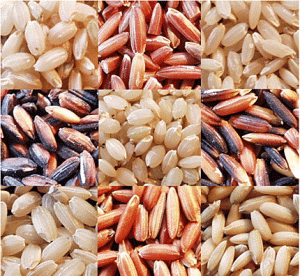Traditional rice of Sri Lanka
Traditional Rice of Sri Lanka
Sri Lanka, an island nation in the Indian Ocean, is renowned for its rich biodiversity, which extends to its agricultural practices, especially rice cultivation. Rice is not just a staple food in Sri Lanka but also an integral part of the country's culture, economy, and traditional agricultural systems. The traditional rice varieties of Sri Lanka are a testament to the country's rich agricultural heritage and biodiversity.
History and Significance[edit | edit source]
Rice cultivation in Sri Lanka dates back over 2500 years, with ancient texts and archaeological findings providing evidence of this long-standing tradition. The ancient Sinhalese developed sophisticated irrigation and water management systems, such as tanks, reservoirs, and canals, to support the cultivation of rice. These traditional varieties were cultivated using organic farming methods, long before the advent of modern agricultural practices.
Traditional rice varieties are known for their resilience to pests and diseases, tolerance to drought and flooding, and their ability to adapt to various climatic and soil conditions. They are also valued for their nutritional benefits, including higher levels of vitamins, minerals, and antioxidants compared to modern hybrid or genetically modified varieties.
Types of Traditional Rice[edit | edit source]
There are over 2000 traditional rice varieties recorded in Sri Lanka, each with unique characteristics, flavors, and nutritional profiles. Some of the notable varieties include:
- Suvandal: A fragrant white rice known for its rich aroma and soft texture.
- Madathawalu: Recognized for its high nutritional value, particularly its high content of vitamins and minerals.
- Kalu Heenati: A black rice variety, rich in antioxidants and believed to have medicinal properties.
- Pachchaperumal: A red rice variety, valued for its high fiber content and health benefits.
Cultivation and Challenges[edit | edit source]
The cultivation of traditional rice varieties is labor-intensive and yields lower production compared to modern high-yielding varieties. However, the interest in traditional rice is growing, driven by a renewed focus on sustainable agriculture, health, and nutrition. Farmers practicing organic farming and sustainable agriculture are increasingly adopting traditional rice varieties, recognizing their benefits for the environment and health.
One of the major challenges in the cultivation of traditional rice varieties is the lack of seeds and the knowledge required to grow them. Many traditional varieties have been lost due to the shift towards more productive but less resilient modern varieties. Efforts are being made by the government, non-governmental organizations, and farming communities to conserve and revive these traditional varieties through seed banks and community-based conservation programs.
Cultural and Economic Importance[edit | edit source]
Traditional rice varieties are deeply embedded in Sri Lankan culture, featuring in traditional ceremonies, festivals, and culinary practices. They are an essential part of the country's food heritage, offering a unique taste and nutritional benefits that are increasingly being recognized and valued.
Economically, traditional rice varieties offer opportunities for small-scale farmers to diversify their income through niche markets that value organic and traditional foods. There is a growing domestic and international market for traditional rice varieties, driven by consumers' increasing interest in health, nutrition, and sustainable agriculture.
Conclusion[edit | edit source]
The traditional rice varieties of Sri Lanka are a vital part of the country's agricultural heritage and biodiversity. Preserving these varieties is crucial for food security, nutrition, environmental sustainability, and the preservation of cultural identity. Efforts to revive and promote traditional rice cultivation are essential in ensuring that these ancient grains continue to be a part of Sri Lanka's future.
This article is a agriculture stub. You can help WikiMD by expanding it!
Search WikiMD
Ad.Tired of being Overweight? Try W8MD's physician weight loss program.
Semaglutide (Ozempic / Wegovy and Tirzepatide (Mounjaro / Zepbound) available.
Advertise on WikiMD
|
WikiMD's Wellness Encyclopedia |
| Let Food Be Thy Medicine Medicine Thy Food - Hippocrates |
Translate this page: - East Asian
中文,
日本,
한국어,
South Asian
हिन्दी,
தமிழ்,
తెలుగు,
Urdu,
ಕನ್ನಡ,
Southeast Asian
Indonesian,
Vietnamese,
Thai,
မြန်မာဘာသာ,
বাংলা
European
español,
Deutsch,
français,
Greek,
português do Brasil,
polski,
română,
русский,
Nederlands,
norsk,
svenska,
suomi,
Italian
Middle Eastern & African
عربى,
Turkish,
Persian,
Hebrew,
Afrikaans,
isiZulu,
Kiswahili,
Other
Bulgarian,
Hungarian,
Czech,
Swedish,
മലയാളം,
मराठी,
ਪੰਜਾਬੀ,
ગુજરાતી,
Portuguese,
Ukrainian
Medical Disclaimer: WikiMD is not a substitute for professional medical advice. The information on WikiMD is provided as an information resource only, may be incorrect, outdated or misleading, and is not to be used or relied on for any diagnostic or treatment purposes. Please consult your health care provider before making any healthcare decisions or for guidance about a specific medical condition. WikiMD expressly disclaims responsibility, and shall have no liability, for any damages, loss, injury, or liability whatsoever suffered as a result of your reliance on the information contained in this site. By visiting this site you agree to the foregoing terms and conditions, which may from time to time be changed or supplemented by WikiMD. If you do not agree to the foregoing terms and conditions, you should not enter or use this site. See full disclaimer.
Credits:Most images are courtesy of Wikimedia commons, and templates, categories Wikipedia, licensed under CC BY SA or similar.
Contributors: Prab R. Tumpati, MD


